DDA Green-Lights Housing, Transportation
Ann Arbor Downtown Development Authority board meeting (Oct. 3, 2012): At its most recent meeting, the DDA board approved four resolutions – two related to downtown housing and two related to transportation.

DDA board member Roger Hewitt looks at a sample of the roof material that will be installed at Baker Commons. (Photos by the writer.)
Getting approval from the board was a $260,000 request from the Ann Arbor housing commission (AAHC), the bulk of which will pay for the emergency replacement of the roof on Baker Commons, a 64-unit public housing complex located at the intersection of Packard and Main streets. The sharply pitched roof will be made of steel, and is expected to last for 50 years, though it’s guaranteed for 20. Overall the board was positively inclined toward the request, but board member Newcombe Clark also wanted a clearer idea of how the DDA’s contribution fit into the AAHC’s capital maintenance and replacement schedule.
Also getting approval from the board was a resolution that authorized negotiating an arrangement for around 42 parking spaces in the public parking system for a proposed residential development at 624 Church St. The 13- or 14-story, 83-unit apartment building will include about 181 beds – a residential use that allows the project to qualify for a by-right “premium” under the city’s D1 (downtown core) zoning code.
The parking spaces for 624 Church St. can be provided through a contribution-in-lieu (CIL) program instead of providing them on site. That CIL program is administered by the DDA, because the DDA manages the public parking system under a contract with the city of Ann Arbor.
While the CIL authorization was perhaps at first glance only about housing, not transportation, two other items on the agenda were more obviously transportation-related.
A transportation connector study got a $30,000 contribution from the DDA. It’s contingent on the city of Ann Arbor contributing $30,000 as well, which is not a certainty. The total of $60,000 in city sources is part of $300,000 in local matching funds required for an already awarded $1.2 million federal grant. The remaining $240,000 is coming from the University of Michigan ($150,000) and the Ann Arbor Transportation Authority ($90,000). The corridor to be studied runs from US-23 and Plymouth southward along Plymouth to State Street and farther south to I-94. This alternatives analysis phase of the study is to result in identifying a preferred mode – such as bus rapid transit or light rail – and the location of stations and stops.
The board also authorized a 50-bike storage facility that would have the footprint of two vehicle parking spaces. The “cage” will be located in the downtown Ann Arbor’s Maynard Street parking structure.
In addition to the monthly parking report, the board received an update on the electric vehicle charging stations that are located in public parking structures.
Baker Commons Roof
The board considered a resolution to authorize $260,000 for the roof replacement at Baker Commons, a public housing unit in downtown Ann Arbor.
Baker Commons offers 64 of the roughly 360 public housing units managed by the Ann Arbor housing commission. The DDA’s allocation includes a small amount for other energy-saving investments in the building.
Jennifer L. Hall, the commission’s executive director, had addressed the board at its Sept. 5, 2012 meeting and also spoke to board members on Oct. 3.
Baker Commons, on the corner of Packard and Main streets, is the only AAHC property within the Ann Arbor DDA district. The roof has had ongoing leaking problems, according to Hall’s presentation at the Sept. 5 meeting, and the housing commission has undertaken periodic patches. However, in the last year or so it is gotten much worse, Hall reported. There has been leakage into housing units and damage to the roof trusses.
The housing commission is planning to put a steel roof on Baker Commons, even though the upfront cost is about three times more than an asphalt roof. A steel roof will be more durable. Some of the benefits for the steel roof include: no off-gas; resistance to wind, fire, mildew, insects and rot; extended life for air-conditioning units; decrease in attic temperatures; and decreased energy use overall. It also decreases the heat-island effect, according to Hall. She also pointed out that the product chosen by the housing commission is made in Michigan.
Baker Commons Roof: Public Commentary
During public commentary, AAHC executive director Jennifer L. Hall addressed the board about the request. She had also appeared before the board at the previous month’s meeting. She described how the AAHC provides low-income public housing in the city – a total of around 360 units. Of those, 64 units are located at Baker Commons, the facility that she was requesting funds to support. She described the residents of Baker Commons as mostly elderly or disabled, all living in one-bedroom units.
Hall described the Baker Commons roof has having ongoing structural problems. It had shown such a rapid deterioration that it needs to be replaced before the winter, she said. The choice of a steel roof, as opposed to asphalt, she said, reflects the AAHC’s desire to try to use more durable, longer-lasting products. Because the building is six stories tall, she said, replacing the Baker Commons roof would require the use of scaffolding and would be fairly expensive, regardless of the material used. [At the DDA's September meeting, Hall had described the upfront material cost of steel compared to asphalt as about three times as much.] She felt that the roof would last 50 years or longer.
With part of the $260,000 request, the AAHC would be installing devices – like sensors and programmable thermostats – that would result in reducing energy costs to the building. That saved money could be put back into the building, she said. Hall told board members that AAHC would like to put a sign out front of Baker Commons thanking the DDA. She said she’d love to be able to tell the city council, when she addressed that body the following week, that the DDA is supporting the AAHC in this way.
Ray Detter reported from the downtown citizens advisory council (CAC), saying that group strongly supports the Baker Commons request. The CAC would like to see a carefully constructed program for all affordable housing so that those needs are met, but not just necessarily in the downtown.
Baker Commons Roof: Board Discussion
Sandi Smith led off deliberations, saying that the board had now heard twice from the executive director of the Ann Arbor housing commission, Jennifer L. Hall, with the request. She described the location of Baker Commons as solidly within the DDA district. The DDA had the ability to provide money from the DDA’s housing fund as well as from its TIF (tax increment finance) fund.
“To me, this seems like a no-brainer,” Smith said. She characterized it as an investment in sustainability, and consistent with the goal of having affordable housing within the downtown. Joan Lowenstein pointed out that Baker Commons is housing that is already in the downtown. It’s to the community’s advantage that it stays nice and presentable and doesn’t fall apart. It’s not a question of whether to build more housing or not – it’s already there, and it’s part of the DDA’s job to help take care of it, she said.
Newcombe Clark responded to the characterization of the replacement of the roof as an emergency. He wanted to know if there’d been any conversation about depreciation accounts and capital reserves. A roof is only one piece of a building that might fail. Smith noted that the AAHC had conducted an audit on all its buildings. The roof was looked at three years ago and had deteriorated rapidly – much sooner than anyone had expected. AAHC is absolutely behind in its budgets for maintenance and repair of housing commission properties. There’s no doubt it’s underfunded, she said, and there’s no apparent stream of funds that can be put toward that. The steel roof reflects that AAHC is taking a longer-term approach. The steel roof is guaranteed for 20 years, but Hall had said a steel roof would typically last for 50 years, Smith noted.
Clark wondered if there were a “pipeline” of other AAHC needs that will likely come to the DDA board as requests. Asked to come to the podium, Hall described Baker Commons as one of the better-maintained buildings owned by AAHC. She described how AAHC gets a capital fund allocation each year from HUD [the U.S. Dept. of Housing & Urban Development] that has to cover all AAHC properties. So AAHC has a five-year plan for all its properties, which identifies the highest needs, she said. However, AAHC funding from HUD keeps getting cut, so AAHC is behind in addressing its capital needs.
Several projects are being undertaken at Baker Commons, including the replacement of all windows and flooring, she said. The flooring will be linoleum instead of carpet, because residents complain that the carpeting can’t be kept clean. As far as upcoming request to the DDA, she mentioned the flooring as well as a parking lot improvement – probably a year or two from now. The possibility of solar or wind energy was also something being contemplated for the future. Baker Commons is not by any means one of the worst properties, she said, adding that in fact it’s one of the best.
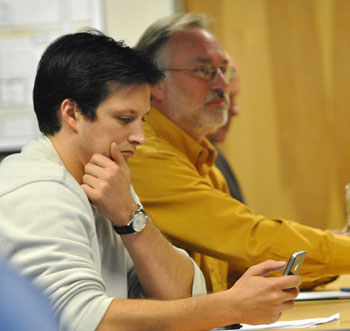
Newcombe Clark before the DDA’s Oct. 3 meeting started. Beside him is fellow board member John Mouat.
At the conclusion of the meeting, Hall returned to address the board during the final occasion for public commentary. She described an effort to access private financing – driven in part by HUD’s encouragement to do that in the long term. The idea is to convert public housing to partial private ownership through long-term vouchers. She indicated that this might be something the AAHC would approach the DDA to help facilitate.
Clark allowed that the DDA had the money to spend on this, but also noted that the housing fund could be used to construct new units. So it would be important to know if the DDA was being asked to fund a depreciation schedule. If so, he’d like to know what the depreciation schedule is. He called an emergency roof replacement “a symptom of a larger problem.”
Mayor John Hieftje, who serves on the DDA board, observed that funding from HUD showed a downward trend over several years, so he appreciated that a roof is being funded that will last for a very long time. Roger Hewitt got clarification from Sandi Smith that $246,000 of the allocation was coming from the DDA’s housing fund and $14,000 from the TIF fund.
Outcome: The $260,000 allocation for Baker Commons roof replacement was unanimously approved.
624 Church St. Parking Spaces
The board considered a resolution that would authorize negotiation of a contract with a residential development at 624 Church St. for up to 42 parking spaces in the public parking system, which is managed by the DDA under a contract with the city.
The proposed building at 624 Church St. in downtown Ann Arbor would be a 13- or 14-story, 83-unit apartment building for approximately 181 beds. The project exceeds the basic 400% floor area ratio (FAR) specified under the D1 (downtown core) zoning, but qualifies for a premium based on the residential use. [FAR is a measure of density – the ratio of the square footage of a building divided by the size of the lot. A one-story structure built lot-line-to-lot-line with no setbacks corresponds to a FAR of 100%. A similar structure built two-stories tall would result in a FAR of 200%.]
For the basic 400% FAR, no parking is required. But for the excess amount, the city’s parking code requires that parking be provided. One option for handling the required parking is to use the “contribution in lieu of parking” program.
Ann Arbor’s “contribution in lieu of parking” program was authorized by the city council on April 2, 2012. The program allows essentially two options: (1) purchase monthly parking permits in the public parking system for an extra 20% of the current rate for such permits, with a commitment of 15 years; or (2) make a lump sum payment of $55,000 per space. It’s option (1) that the 624 Church St. project will be pursuing.
At the Sept. 26 meeting of the DDA’s operations committee, the development team for 624 Church St. pitched the parking proposal to the committee. Given the added capacity in the public parking system resulting from construction of the new underground parking garage – Library Lane, which offers over 700 spaces – committee members were generally positively inclined to make an arrangement for 40 permits somewhere in the parking system.
But the operations committee was not willing to commit to offering spaces in the Forest Avenue parking structure, which is the closest parking facility to the project. That was reflected in the Oct. 3 resolution considered by the board, which describes how it will be decided “at a later date where these 42 parking spaces will be assigned, including in the Forest Avenue parking structure or within other nearby campus-area public structures … ”
The 624 Church St. address is next to Pizza House. Dennis Tice, owner of Pizza House, is listed as one of the developers, along with 624 Partners LLC and Opus Group of Minnetonka, Minnesota. [.pdf of 624 Church Street proposal] When Pizza House expanded in 2006, the project included foundations that would allow for a taller building to eventually be constructed. The new project would demolish an existing two-story house located south of the restaurant, replacing it with a 14-story building over the southern portion of the restaurant and above the former house and loading zone area. The design by local architect Brad Moore would include a rooftop plaza and garden. [.jpg of proposed 624 Church Street project]
624 Church St. Parking Spaces: Public Commentary
During public commentary, Dennis Tice introduced himself as the owner and operator of the Pizza House, on top of which the project would be built. He introduced project architect Brad Moore, who spoke on Tice’s behalf.
Moore described the project as an addition to the Pizza House structure – a residential tower with 13 occupied levels and a roof plaza as an amenity. It will be constructed over two-thirds of the site, he said. The original Pizza House restaurant took up the northernmost third of the site, he said. An addition to the restaurant takes up the middle third of the site. And on the southernmost third of the site stands a two-and-a-half story house, which would be demolished, he said. The new construction would occupy the southern third and extend over the top of the middle third of the site. When the restaurant addition was designed, it included a foundation system that could handle an additional vertical addition. So part of the project is already “in the ground,” Moore said.
Because of the narrow footprint of the southern third of the site, Moore continued, the developer can’t find any way to accommodate parking on site – which would be required for the residential premium FAR. So what’s being requested is to satisfy the parking requirement by contracting for 40-42 spaces in the public parking system, as provided in the city’s contribution in lieu (CIL) program. Moore stated a preference that the spaces be located in the Forest structure, but said he understood it’s up to the DDA to figure out the location.
Moore noted that the Oct. 17 meeting of the design review board would mark the first occasion on which input would be received from the city about the project. But in terms of the process, the developer needs to be able to say whether the parking will be available and can be provided through the city’s CIL program.
Local attorney Scott Munzel addressed the board in support of the Opus Group, which is developing the project. Munzel described Opus as an experienced real estate developer, including student rentals as well as more typical multi-family developments. Opus is a regional entity, he said, with offices in Indianapolis and Chicago as well as on the east coast. Opus is a good solid developer to undertake the project, Munzel said. Obviously, he added, the site is part of the South University Avenue commercial district and he characterized the project as appropriate for the location. Opus had asked Munzel to appear to strongly urge that the spaces to be provided through the CIL program would be provided in the Forest parking structure, across the street from the project. However, Munzel allowed that Opus understands it’s a systemwide decision.
Ray Detter, reporting from the downtown citizens advisory council (CAC), said he felt the 624 Church St. project seems to take care that it follows the design guidelines. He added that this contrasted with a different project also currently proposed on East Huron Street. [For more detail on the two projects, see "Two Projects File for Design Review"]
Detter said the CAC also supported the off-site parking request being made under the CIL program.
624 Church St. Parking Spaces: Board Discussion
Roger Hewitt noted that under the relatively new A2D2 rezoning process, there’s a provision for projects that are required to have parking if they exceed the 400% FAR. Under the CIL option for providing the required parking, Hewitt noted, there’s an option to sign a contract with the DDA to have monthly permits. There’s also an option to make a lump sum payment to the DDA. For this project, the request is to sign a contract for up to 42 spaces, Hewitt said.
Newcombe Clark drew out the fact that the 624 Church St. project is a “by-right” project. Hewitt described the project as above 400% FAR, but it’s not a planned unit development (PUD).
On clarification that to meet the “by-right” standard, a contract had to be made for spaces somewhere in the public parking system, Clark wondered why a reference needed to be made to the Forest parking structure in the resolution. DDA executive director Susan Pollay confirmed that the CIL policy is silent on where the spaces would be – it simply requires that the contract for the spaces specify permit prices at 20% greater than the going rate.
Clark was concerned about the ability of the DDA to implement demand management strategies – pointing out that there’s a greater utility to the developer to have the spaces provided at the Forest structure. When the Forest structure was rebuilt, it was constructed with just 590 spaces, and the demand for parking in that area is increasing. In terms of the project approval, the city needs confirmation from the DDA that 42 spaces are available somewhere in the public parking system.
Clark wanted to eliminate the statement in the resolution that referred specifically to the possibility that the parking spaces would be provided in the Forest structure.
Several board members seemed amenable to Clark’s attempted friendly amendment. But mayor John Hieftje was satisfied by the original statement’s “or.” Clark felt it was still “anchoring” in the course of negotiations. Board chair Leah Gunn, who was presiding over the meeting, deemed that Clark’s amendment was no longer considered friendly – and would need a board vote and a formal move by Clark to bring it to a vote. Clark was content not to move for the amendment, but noted that 42 spaces in the Forest structure is a significant percentage of the deck. Keith Orr was successful in adding a friendly amendment that mentioned the use of demand management principles.
Outcome: The board unanimously approved contracting for 42 spaces in the public parking system for the 624 Church St. project.
$30K for Transit Connector
The board was asked to consider a resolution allocating a total of $30,000 over two fiscal years as a contribution to a $1.5 million project – the study of a transportation connector between the northeast and south sides of Ann Arbor. The corridor runs from US-23 and Plymouth southward along Plymouth to State Street, then farther south to I-94. This alternatives analysis phase of the study is to result in identifying a preferred choice of technology (e.g., bus rapid transit, light rail, etc.) and the location of stations and stops. The decision to help fund the project was made at the DDA board’s Oct. 3, 2012 meeting.
The grant from the DDA to the project would come from parking revenues, split equally between the current fiscal year (2013) and next year. It also would be contingent on the city of Ann Arbor providing $30,000 to the project, too.
The additional $30,000 from the DDA – when added to $150,000 that the University of Michigan has pledged, $90,000 from the Ann Arbor Transportation Authority, and a possible $30,000 from the city – would bring the total local funding to $300,000. That would satisfy the 20% matching requirement for a $1.2 million grant the AATA has received to complete the $1.5 million project.
The AATA has given approval of a contract with URS Corp. to start the work, contingent on lining up the remaining $60,000 in local matching funds.
Whether the Ann Arbor city council would decide to allocate $30,000 to the project is an open question. Previously, when the council was asked to provide $60,000, the proposal was rejected. The council voted on Sept. 4, 2012 to reject it, then reconsidered that vote two weeks later on Sept. 17, 2012. But on reconsideration of the vote, the council decided to postpone a decision until Oct. 15.
Part of the political mix is the need for the 11-member council to achieve an eight-vote majority – because the resolution reflects a change to the city budget. If the council approves the money on Oct. 15, it will be without the vote of Stephen Kunselman (Ward 3), who previously voted for the funding, despite some strongly expressed concern. Kunselman announced at the council’s Oct. 1 meeting that he would not be able to attend the meeting on Oct. 15.
And based on the Sept. 4 deliberations, Mike Anglin (Ward 5) and Jane Lumm (Ward 2) would be likely votes against it. That means approval would require unanimity across the rest of the council, including Sabra Briere (Ward 1) and Marcia Higgins (Ward 4). While Higgins was absent for the Sept. 4 vote, Briere was present and voted against the funding.
$30K for Connector Study: Board Discussion
Roger Hewitt reviewed the process to date. He noted that the project is following federal guidelines for funding. The first phase had been a feasibility study and has already been completed. The alternatives analysis phase is to look at technology and routes, which will produce a locally-preferred alternative, he said. He described it as a “transit spine” through the city.
Hewitt described the study as lasting about 1.5 years at a total cost of $1.5 million. Of that amount, a federal grant will pay for $1.2 million. The $90,000 from the AATA and $150,000 from UM leaves a balance of $60,000 for local matching funds that must be identified, he said. Hewitt noted that the Ann Arbor city council would be taking up the issue at its Oct. 15 meeting, but he did not review the complications of the council’s action up to now.
Hewitt called it “critical” for the DDA to be involved – as the DDA looks at the increasing parking numbers. As more people visit downtown and work in downtown, they need to be able to get into the downtown some other way, he said, noting that “we’re going to run out of parking capacity faster than we thought we were, and we’re certainly going to run out of street capacity faster than we thought we were.”
So Hewitt said he was proposing that the DDA fund half of the remaining local share – $30,000 to be split into two $15,000 chunks over the next two fiscal years. Hewitt also stressed that the allocation is contingent on the city contributing $30,000 as the final share. “We want to be in lock step with what the city council is doing,” Hewitt said. If the city council doesn’t see it as appropriate, he said, “so be it.” The advantage of being able to leverage federal funds is critical not just for the study, but for the eventual construction of a transportation connector.
Sandi Smith felt that the proportionate share was right for the University of Michigan, given that UM will get a huge benefit – because the institution needs to move people back and forth between its campuses.
Keith Orr said that an additional benefit to contributing to the project was that it would increase the amount of money the DDA is putting toward alternative transportation. He saw it as important to be at the table.
Responding to a question from John Splitt, Hewitt indicated that the timing of the contribution was not as important as the commitment.
Outcome: The board unanimously approved the contingent $30,000 for the transportation connector study.
Bike Parking Cage
The board considered authorization of $30,000 from its parking fund to pay for a 50-bike storage facility – to be located in the downtown Ann Arbor Maynard Street parking structure.
The money covers design, fabrication and installation of the bicycle storage facility. Similar “cages” in other cities use a chain-link fencing material. However, the DDA hopes that a more aesthetically pleasing option can be identified.
The facility is designed for commuters who would pay a rental amount for use of the “cage.” Bicyclists would still be responsible for securing their own bikes in racks inside the cage. The revenue from the rentals would go to the DDA to compensate for the lost revenue from the automobile parking spaces. The getDowntown program, which is formally a creature of the Ann Arbor Transportation Authority, would receive a yet-to-be negotiated portion of that revenue in exchange for managing the program. The getDowntown program already manages some downtown bicycle lockers.
Based on discussion by DDA and getDowntown staff at a Sept. 26 DDA operations committee meeting, the current intent is to make the cage available only to holders of the go!pass – a bus pass that downtown employers can purchase for their employees at a cost of $10 per year. The cost of the go!pass rides is subsidized by the DDA.
Also at the Sept. 26 committee meeting, it was reported that Barracuda Networks believes that as many as 25 of its employees are potential users of the bike cage facility. Barracuda was recently granted a tax abatement by the Ann Arbor city council in connection with its move from Depot Street to a downtown location immediately adjacent to the Maynard Street parking structure, where the cage is to be located.
Bike Parking Cage: Board Discussion
John Mouat gave a brief overview of the proposal. He hoped that it could become a model for other locations. He noted that Barracuda Networks – which is moving to that location – might have as many as 25 potential users. Roger Hewitt observed that some of the bike lockers previously were located at the Maynard Street structure. He said based on his own observations, there’s clearly a need for bicycle parking in the area. He characterized it as a good pilot project. Mouat added that the bicycle cage fits into the idea of connecting different parts of town.
Outcome: The board unanimously approved the allocation for the Maynard Street bicycle cage.
Parking Report
Roger Hewitt gave the monthly update on parking usage, the most recent numbers coming from August 2012. The total number of spaces has gone up, he noted – thanks to the opening of the Library Lane underground parking garage on South Fifth Avenue. Revenues continue to be strong he said. – a 14% growth in revenue compared to a year ago. Patron counts are also up slightly for the hourly parking. The Library Lane structure had just opened and a lot of people don’t know it’s there, he said, yet it still contributed $43,000 to the total, which means that at least some people have found it and are using it.
Permit sales continue to be very strong, he said. Some people have moved their monthly permits from Liberty Square to the new Library Lane structure. [The DDA is offered reduced rates for those who choose to make that move. About 100 people have taken advantage of the offer.] Hewitt called it an encouraging report, adding that it indicates the system is growing faster than the DDA thought it would. It would be a focus of the operations committee to deal with the increased parking demand.
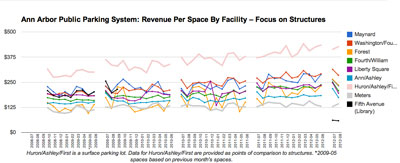
Revenue by space: Focus on structures. Chronicle charts of Ann Arbor public parking system from DDA data.
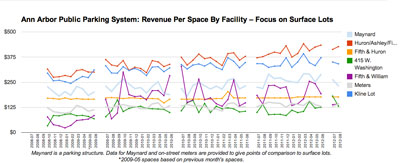
Revenue by space: Focus on surface lots. Chronicle charts of Ann Arbor public parking system from DDA data.
Communications, Committee Reports
The board’s meeting included the usual range of reports from its standing committees and the downtown citizens advisory council.
Comm/Comm: Board Retreat
Susan Pollay, executive director of the DDA, reported on the scheduling of the board retreat. [It's now been finalized at Nov. 16 from 10:30 a.m. to 3:30 p.m. at Zingerman's on Fourth.]
Comm/Comm: Proceeds of City-Owned Land Sale
Sandi Smith reported on the supportive resolution the DDA board had approved at its meeting the previous month – which encouraged the city council to adopt a policy that would deposit the proceeds of city-owned land sales to the city’s affordable housing trust fund. The issue has now been referred to the council’s budget committee, Smith said, and the committee is “chewing” on it and will come back to the full council on Oct. 15. [Based on a committee meeting held on Oct. 1, it seems likely that any policy directing proceeds of city-owned land sales to the affordable housing trust fund would be limited to just one property – the Fifth and William surface parking lot, which was the former location of the YMCA building. For other city-owned properties, the committee seemed more inclined to decide on the use of proceeds on a case-by-case basis.]
Comm/Comm: Connecting William Street
Joan Lowenstein gave an update on the scheduling of additional public engagement events associated with the Connecting William Street project.
The project’s leadership and outreach committee will meet on Oct. 17 at 3 p.m., Lowenstein said. That will be the first meeting in a while – because the group was waiting until data had been gathered from the public engagement process. That still puts the committee on track to make a recommendation to the city council in December.
As a part of the recommendation, the committee wants to be clear to the council about what the DDA is willing to invest and what the public should be willing to invest in the area covered by the CWS process, Lowenstein said. The committee had begun discussing the issue at its regular meeting and continued at a special meeting. The committee had discussed making infrastructure improvement along the same lines as those made for Fifth and Division streets.
The committee had also looked at use of TIF (tax increment finance) dollars for other public improvements – like stormwater and drinking water. Lowenstein reported that within the CWS study area, the city has already been gradually improving the infrastructure, so it’s not like it has to be done from scratch, she said. The committee is also looking at how investments in transportation and parking would support more residents and businesses, she said. That includes increasing bike lanes, pedestrian improvements, and pathways that would connect Main Street to State Street. Sandi Smith followed up by saying that the connections were also crucial – when often the focus was just on the surface parking lots.
Comm/Comm: Bicycles on Sidewalks
Ray Detter, reporting from the downtown citizens advisory council (CAC), recalled how nearly a decade ago, Dick Shackson had succeeded in advocating for the installation of the first “walk your bike” signs on State Street and East Liberty. Since then, Detter said, the number of pedestrians, cyclists and sidewalk diners in the downtown had increased enormously, he said. He had been asked by the CAC to give full support for an expanded “walk your bike” program on the most congested sidewalks in downtown – at the same time that a commitment is made to making the streets safer for everyone. [For background, see this Dec. 8, 2003 Ann Arbor News article: "Proposal would turn riders into pedestrians – DDA hears recommendation bikes be walked"]
Reporting from the DDA’s transportation committee, John Mouat said that a sub-committee had been formed to look at the issue of riding bicycles on downtown sidewalks. Mouat is on the sub-committee, along with Russ Collins and John Splitt.
Comm/Comm: Electric Vehicle Charger Project
The board got an update from Dave Konkle on the electric vehicle charger project in the public parking structures. Konkle introduced himself as the former energy coordinator for city of Ann Arbor, who’s now consulting on energy projects for the DDA.
He characterized the electric charger as near completion, and showed the board members a preview of the website that will display data about usage of the chargers. [At the time of the presentation to the board, the website was not yet launched. Shortly after Konkle spoke to the board, it went live.
Eighteen charging stations are located in six different public parking structures. The website displays which of the chargers are available in real time. The website also tracks the net number of miles that have been supplied to cars using the public charging stations. Currently the electricity used to charge a patron's car is free as long as the parking is paid for. That could change in the future, Konkle said. When the system was set up, flexibility was built in so that if the DDA wants to charge for the electric use, that's easy to implement – by adding a card reader. Decisions will be made as demand grows, he said.
Konkle used the example of the stations at the Forest parking structure to illustrate how the website works. He described how a group of users of the two stations had evolved. They'd contacted Konkle with some requests. They'd figured out that the cord to the charger will reach as far as an immediately adjacent space not designated for use of the stations – so they'd asked that those spaces also be designated as reserved for the electric charging station. The group has created a window system to indicate when they think their car will be done charging. Konkle quipped that they are Midwesterners, so they feel bad if they park there for eight hours with no one else able to use the charger. So the group has exchanged cell phone numbers, Konkle reported, and they move their cars around throughout the day. More charging stations have been requested, Konkle said.
Usage at the Fourth and William structure is also high, Konkle said. To give board members a rough idea of how much the electricity is costing, he said 10 kWh of electricity is about $1.20. So every day, each charging station is costing around $1.20 or slightly more, he said.
Konkle characterized the usage as good compared to other cities. Other cities would be jealous to see the usage, he said, and would never believe the kind of usage that is being achieved at Forest. Usage is above what was expected, he said. Before the installation, he'd told members of the project team that some people would look at 18 chargers as far too many for the usage they'd get, while others would say that was too few.
Present: Newcombe Clark, Bob Guenzel, Roger Hewitt, John Hieftje, John Splitt, Sandi Smith, Leah Gunn, Keith Orr, Joan Lowenstein, John Mouat.
Absent: Nader Nassif, Russ Collins.
Next board meeting: Noon on Wednesday, Nov. 7, 2012, at the DDA offices, 150 S. Fifth Ave., Suite 301. [Check Chronicle event listing to confirm date]
The Chronicle could not survive without regular voluntary subscriptions to support our coverage of public bodies like the Ann Arbor Downtown Development Authority. Click this link for details: Subscribe to The Chronicle. And if you’re already supporting us, please encourage your friends, neighbors and colleagues to help support The Chronicle, too!





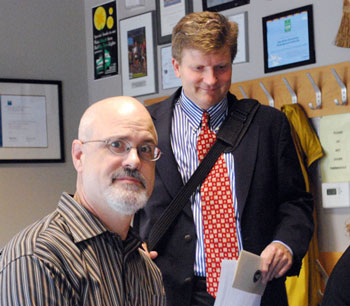
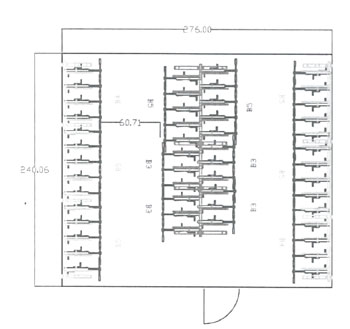
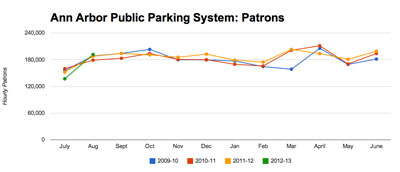
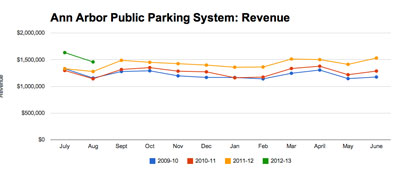
Why are we charging bike riders to park while subsidizing electricity for car drivers? How does that fit in with the City’s sustainability goals?
“The committee had discussed making infrastructure improvement along the same lines as those made for Fifth and Division streets.”
The Fifth and Division project is not complete. The DDA cut out areas of Fifth Avenue around Kerrytown and between William and Packard before putting it out to bid. Even though bids came in over $1 million below budget, nothing was added back. Where did that money go?
Before the DDA puts money into another streetscape project in another area, it ought to account for the money that was supposed to go to Fifth and Division, and then finish that project. There are significant gaps in this “traffic calming” project and incredibly, they are in two of the most pedestrian-heavy areas of Fifth Ave.: The Kerrytown/Farmers Market/Community High area; and the blocks south of William, the densest residential strip on Fifth Ave., which, in addition to the City Place mega-development, also includes the driveway exits for Muehlig and Bethlehem Church.
It also strikes me as odd that the Fifth and Division or underground garage projects did not include a new mid-block pedestrian crossing of Fifth, connecting Library Lane with Blake Transit Center; perhaps this could be part of the Blake reconstruction.
@3: That’s because we have no strong leadership in this City. Strong leadership would have advocated for inter-agency cooperation on these two blocks instead of each entity operating in a virtual vacuum (DDA, AADL, AATA, City, etc.), building its own project as if the others don’t exist. We also have no clue what is to become of the library or former YMCA sites, if anything.
Cooperative planning and urban design could have reduced redundancies, lessened impacts of construction, and created a plan for this so-called “civic corridor” that improved the flow (pedestrian and vehicular) among the various uses. Instead, each entity is rushing to complete its own piece, with its own plan, on its own timeline and with its own money. The result could be almost continuous construction on this block for a decade and wasted tax dollars as streets are dug up and repaired time and time again, among other redundant activities.
RE: “Strong leadership would have advocated for inter-agency cooperation on these two blocks instead of each entity operating in a virtual vacuum (DDA, AADL, AATA, City, etc.), building its own project as if the others don’t exist.”
The specific point prompting that comment was this previous comment: ” … did not include a new mid-block pedestrian crossing of Fifth, connecting Library Lane with Blake Transit Center; perhaps this could be part of the Blake reconstruction.”
The original site plan for the Libary Lane parking garage shows a midblock crossing on Fifth Avenue. [large .pdf of plan]. As the Blake Transit Center plans developed – with placement on the Fifth Avenue side of the parcel – the folks from AADL, AATA, and DDA who worked on the BTC project recommended waiting until the exact alignments were known before making the curbcuts, ramps and whatnot. Part of the mix is the possibility of some kind of easement on the south edge of the federal building property as a mid-block connection between Fifth and Fourth. So it’s not that the relevant agencies are oblivious to the fact that a mid-block crossing would be a good idea – it’s that they’re waiting until the location of the crosswalk can be optimized. Weighing the cost and benefit of waiting versus proceeding with crosswalk installation, the apparent conclusion was that it was better to wait. I suppose it’s possible to have come to a different conclusion.
@5: My conclusion is that it would have been better to coordinate all the public projects on this block, and the various connections between them, under one comprehensive plan before any construction took place. How many times will Fifth Avenue be dug up in the next several years for utility connections/disconnections to Blake, a potential new library, a development on the library lot and a development on the Y lot? How many more road closures will be required? How much of this disruption could have been consolidated with some joint planning and some patience?
Yes, let’s wait on the pedestrian crossing while we charge ahead on unneeded parking and road projects. Maybe we should commission an expensive study by outside consultants. I’d hate to throw away hundreds of dollars on paint.